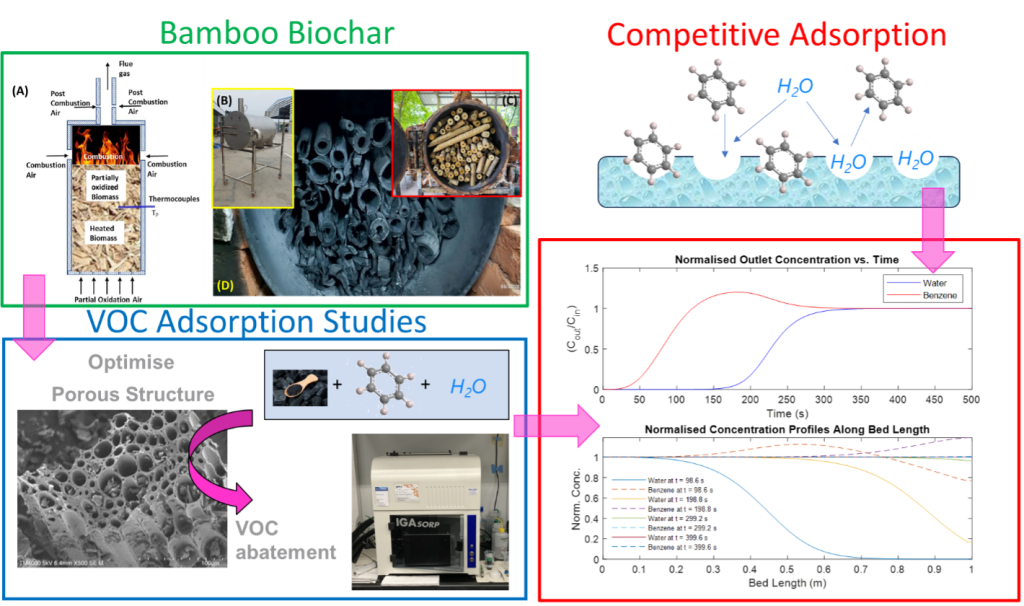Navigation menu
- Education
- Emissions & Air Quality
- Infrastructure & Services
- Meteorology & Climate
- News
- Physical Chemistry
- Projects
- The Team
(Funded by ETH Zürich Leading House Asia to promote Swiss and Thai research collaborations)
Project Description and Objectives

Air quality in airplane cabins is vital due to the presence of harmful volatile organic compounds (VOCs) that can affect passengers’ and crew members’ health (known as Aerotoxic Syndrome). These VOCs, originating from sources like exhaust gases and de-icing fluids, include hazardous substances such as benzene and formaldehyde. Despite the ability of HEPA filters to capture particles, they cannot remove VOCs, which necessitates alternative solutions. Activated carbon (AC) is an effective material for VOC removal due to its porous structure and high adsorption capacity. Activated carbons can be derived from non-sustainable sources; however, this project focuses on using sustainable bamboo to produce activated carbon. The AIRSPACE project represents Assistant Professor Apipong Putkham and Dr. Jon Grahame Bell first joint research initiative, aiming to leverage their expertise in activated carbon research and gas purification. Bamboo is a large part of Thailand’s Bio-circular green economy that aims to foster technological development and help the local communities involved in Bamboo production.
Bamboo, a fast growing and renewable resource with high carbon capture capability, is an ideal candidate for developing sustainable solutions in line with Thailand’s Bio-Circular Green (BCG) economy strategy. The advantages of bamboo as an activated carbon source material include:
Sustainability: Rapid growth and can be harvested without harming the environment
High Biomass yield: High biomass amount per unit area
Carbon Sequestration: Capture and storage of CO2, contributing to climate change mitigation
This project aims to optimize pyrolysis and activation processes to create bamboo-derived activated carbon (BAC) for aviation air purification systems. In real-world applications, the BAC filters must be able to work in humid environments. Therefore, the focus is on understanding competitive adsorption between water and VOCs to improve air purification efficiency. By improving pore volume, pore size distribution, and surface chemistry, the project seeks to enhance VOCs adsorption from humid air streams in aviation settings.
Relevance and Innovativeness
Using bamboo as a sustainable material for activated carbon production is gaining attention. This project will be the first detailed investigation into the physicochemical properties and adsorption characteristics of bamboo-derived activated carbon. It will explore the relationship between surface chemistry, porous structure, and adsorption efficiency, providing insights into the competitive sorption mechanisms. The findings will drive the development of optimised adsorbents and open new market opportunities for Thai communities involved in the BCG concept.
Research Strategy
Figure 1 shows the steps involved in the AIRSPACE project. Firstly, bamboo will be pyrolysed to create a biochar in specialist kilns and then secondly activated by high temperature treatment to open the internal porosity and increase the surface area of the material to form a bamboo activated carbon (BAC). This will allow the BAC to remove more harmful species from the aviation air streams. Detailed H2O and benzene adsorption studies will be performed for single components to understand how much and how quickly the harmful VOCs can be removed from the air stream. We will then build an air purification cartridge to test how will the BAC performs by measuring the breakthrough behaviour (red box in Figure 1), or in other words, how long it takes for the cartridge to saturate with VOC in both dry and humid air streams.

Expected Results and Follow-Up
The project will enhance the understanding of BAC’s physicochemical features control VOCs adsorption under real-world humid conditions. The findings will be published in reputable journals and presented at conferences to promote bamboo as a sustainable adsorbent material. The research will benefit Thai communities by providing valuable information on producing high-performance activated carbons. Additionally, the project will serve as a foundation for future research collaborations focused on sustainable materials and environmental solutions, such as the development of biofuel from bamboo resources using thermochemical techniques.